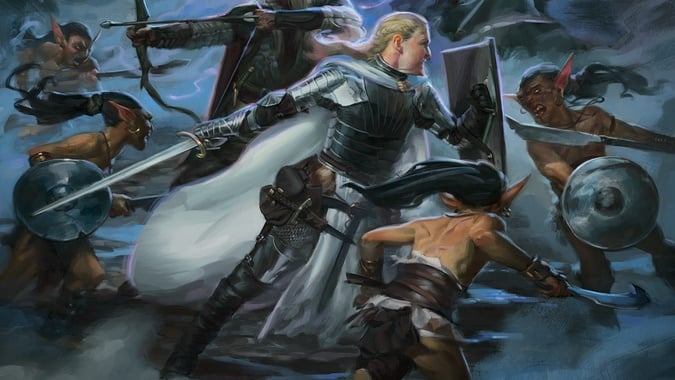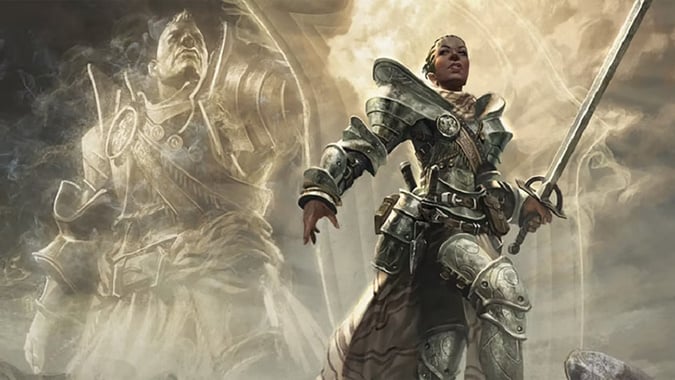Paladins get a glowup in latest One D&D playtest

Alongside the previous look at the Cleric and the fresh new look at the Druid, the newest One D&D playtest material also focuses on another iconic class, the Paladin. While it may be grouped together with those two in the Priest category, Paladins have always conjured a different image, one of the luminous armor-clad avenger, striding into battle to smite their foes with their blades and heal their allies with the laying on of hands.
Good news, Paladin pals: smiting is front and center, and not just the built-in Divine Smite, either.

Spells become slightly more important for Paladins
Paladins in 5th Edition have long been accustomed to using their Divine Smite, fueled by spell slots, to deal extra damage to their foes on successful melee attacks — it’s one of the defining features of the class. In One D&D, that feature is not gone, but it has undergone some important changes. It still requires you to hit a target with an attack, and it still deals 2d8 extra radiant damage to the target in exchange for a 1st-level spell slot, increasing by 1d8 for each level of slot higher than 1st.
In terms of power gains, this is no longer limited to a maximum of 5d8 in exchange for a 4th-level spell slot — you could now feasibly exchange a 5th-level spell slot for a smite of 6d8 radiant damage. You’ll also notice nothing about melee attacks in the description above, and that’s intentional; Paladins can now Divine Smite with ranged weapons or even with their bare fists. In fact, using the new rules for Unarmed Strike, you technically could grapple someone and smite them while doing so. Make no mistake, this is on purpose: in the accompanying official video about the Paladin, Jeremy Crawford states that a lot of Paladins have been asking to “smite-punch” their foes, and this is Wizards of the Coast giving the people what they want: a fist full of holy power. (This also opens up Paladin as a potential fun multiclassing option for Monks, perhaps…)
On the downside, there are a couple of changes to tone the power down a little. Divine Smite no longer automatically gains bonus damage on top of its already-impressive damage if you are smiting an undead or a fiend. Also, it now explicitly states that you cannot smite more than once a turn, nor can you use Divine Smite in the same turn as you cast a spell. That latter restriction is actually meant to force some choices, because alongside the Paladin, Wizards has revamped all the Smite spells from the Player’s Handbook for inclusion in this playtest.
Previously, the Smite spells — Searing Smite, Thunderous Smite, and so on — were extraordinarily clunky to use. You had to cast them before you attacked, you had to be concentrating on them, meaning if you took damage there was a chance it would just fizzle out without doing anything, they didn’t scale with higher-level spell slots at all, and in general they just felt less satisfying to use than the built-in Divine Smite. Now, all of the Smite spells have been revamped as follows:
- Their casting time is now “Bonus Action, which you take immediately after hitting a target with a weapon or an Unarmed Strike” across the board.
- All of them now scale with spell slot level, by adding an additional damage die per level above their starting level.
- They’re part of the Divine Spell list, accessible by both Paladins and Clerics, which isn’t actually a gain for Paladins, but is nice for Clerics who fancy themselves frontliners.
Oh, and you can start using them right away, because Paladins now get spellcasting right off the bat at level 1!

Paladin ability changes for One D&D
A level-by-level breakdown of Paladins demonstrates that the heart of the class is still present, and mostly just getting tweaks and improvements here and there.
- Level 1: Starting right off the bat, as mentioned above, level 1 Paladins now get Spellcasting. No more waiting until 2nd level — and, in fact, Paladins get access to cantrips now! The Divine Spell list includes a lot of the classics that Clerics have been using for a while, since as Sacred Flame and the ever-popular Guidance (newly-revamped to be usable as a reaction, which is how most tables honestly treated it anyway). The 1st-level spells you’ll have access to right away include both spells formerly limited to Clerics and those that only Paladins could cast, so you now have access to things like Guiding Bolt and Sanctuary alongside your Searing Smite and Compelled Duel. Your number of spell slots still grows at exactly the same rate as it did before, but you’ll also end up with 2 or 3 cantrips alongside them.
- Also at 1st level, Lay on Hands functions mostly the same way it did before — it still heals and can remove poisons, but can no longer remove disease — but Divine Sense is gone. Don’t worry, we’ll see it again shortly.
- Level 2: Paladin still has the two other level 2 abilities it had other than spellcasting, Divine Smite (with all the changes detailed above) and your choice of a Fighting Style, which are now Feats. By default, the playtest suggests the Fighting Style: Defense Feat, but you can take whatever one you like, and it also clarifies that you have access to additional Fighting Style Feats when you would normally gain a Feat, even though Paladins are members of the Priest group and not the Warrior group.
- Level 3: grants you your first two charges of Channel Divinity. This is now separate from your Oath — your Subclass — and now is the source of your Divine Sense. Told you it would be back! It also now lasts for 10 minutes (or until you’re Incapacitated), as opposed to one round, and it no longer has the limitation of not being able to detect Celestials, Fiends, and Undead behind total cover. Is there a demon lurking behind that door? Ask your local Paladin!
- You also get to pick your Paladin Subclass at 3rd level and get its first feature. The one included in this playtest set is the Oath of Devotion.
- One thing notably missing at 3rd level is Divine Health. Paladins can catch a cold like anyone else now, I guess.
- Level 4: you get a Feat.
- Level 5: brings you Extra Attack, just like before. But wait, there’s more: you also now have a Faithful Steed. Paladins of 5th level or higher always have the Find Steed spell prepared, and it doesn’t count against the number of spells they can prepare. Casting it takes a single action, doesn’t require a spell slot, and can be cast again after a long rest.
- Level 6: Your second Subclass Feature arrives. This and your Aura of Protection have traded places.
- Level 7: you now get your Aura of Protection. It still radiates ten feet from you, but it no longer penetrates total cover, and it still grants your allies a saving throw bonus equal to your Charisma modifier. Humorously, it also no longer states that you have to be conscious.
- Level 8: you get a Feat.
- Level 9: you learn a new use for Channel Divinity: Abjure Foes. Present your holy symbol or weapon and a number of creatures within 60 feet of you have to make a Wisdom saving throw; if they fail, they’re Dazed and Frightened for 1 minute or until damaged. Even if they succeed, they’re still Dazed for 1 minute or until damaged.
- Level 10: Your third Subclass Feature. This has moved all the way down from 15th level in 5th Edition! However, the old 10th-level ability — where your Aura of Protection also prevented the frightened condition — is now earned later.
- Level 11: Radiant Strikes. Despite the fancy new name, this is the same as the ability formerly called Improved Divine Smite — you now are so suffused with divine might that you just always deal a bonus 1d8 damage. However, unlike Divine Smite, this doesn’t work with Unarmed Strikes; it requires a simple or martial weapon. Seems like an oversight for all those smite-punchers in the audience!
- Level 12: you get a Feat.
- Level 13: Aura of Courage, formerly at 10th level; it actually has improved slightly, in that a frightened ally that moves into your aura will now have that effect suppressed while they’re in your aura. Handy!
- Level 14: your fourth Subclass Feature, which formerly would’ve required you to go to 20th level. There’s been some sensible rebalancing of when Paladins get their Subclass Features, but it means prior existing Subclasses might require some revising to make sure they aren’t too powerful by gaining what was formerly essentially a class capstone ability at 14th level, and a 15th level ability at 10th level.
- Level 15: Restoring Touch, which is a fair bit weaker than their old Cleansing Touch feature. Rather than being able to end a spell on someone for essentially free, you can now expend 5 HP from your Lay on Hands pool (which is 75 points at this level) and instantly end any one of these conditions: Blinded, Charmed, Dazed, Deafened, Frightened, Paralyzed, or Stunned.
- Level 16: you get a Feat.
- Level 17: is when your Auras — both Protection and Courage — extend to 30 feet in every direction.
- Level 18: Divine Conduit is a new ability that formerly would’ve been Paladins’ capstone, if they had one. The new ability is simple and useful — whenever you roll initiative, you regain one use of Channel Divinity
- Level 19: you get a Feat.
- Level 20: this is when you get your Epic Boon, which can take the form of an ability score increase, the Epic Boon of Truesight, or any other Epic Boon Feat of your choice. In general, starting with this playtest, the Epic Boons have been scaled up in power; they’re really supposed to feel like the culmination of your epic adventuring career.

The Oath of Devotion is still a weapon of justice and light
Literally glowing with holy light at their highest level, the Oath of Devotion was the original subclass for Paladins in the Player’s Handbook, and it’s the one in this One D&D playtest packet as well. It’s especially interesting to see how subclasses for Paladins might get rebalanced in light of their abilities arriving at 3rd, 6th, 10th, and 14th levels instead of 3rd, 7th, 15th, and 20th.
First, as always, there are Oath Spells. There’s an interesting buff to these, further emphasizing Paladin spellcasting — you can now cast each of your Oath Spells once for free without using a spell slot, regaining all these free uses on a long rest.
- 3rd level: Protection from Evil and Good, Shield of Faith (the latter replacing Sanctuary)
- 5th level: Aid (replacing Lesser Restoration), Zone of Truth
- 9th level: Aura of Vitality, Blinding Smite (both new to this subclass)
- 13th level: Guardian of Faith, Staggering Smite (the latter replacing Freedom of Movement)
- 17th level: Commune, Flame Strike
It’s not surprising to see two of the Smite spells make it onto the Oath Spell list, since Wizards clearly wants them to be something people want to use. Hopefully their new streamlined usage and scaling damage will help them see use at the table.
As for the actual Oath features, a lot of these will seem familiar, though some have moved around or been tweaked.
- 3rd Level: Sacred Weapon, which right away gives you a new way to use Channel Divinity. For one minute, a Martial or Simple weapon that you are holding adds your Charisma modifier to attack rolls, and each time you hit with it you have the choice of doing its normal damage type or radiant damage. It also emits bright light in a 20 foot radius, and dim light for 20 more feet past that. So far, the same. However, this weapon is no longer explicitly considered to be magical for the purposes of overcoming resistances, and it requires a bonus action to end rather than being able to end it as part of any other action.
- What you don’t get at 3rd level anymore is the ability to Turn Unholy. No more making fiends or undead run away; turning creatures now appears to be explicitly the domain of Clerics. Abjure Foes in the base class is pretty close, anyway — plus it has the side benefit of keeping enemies closer, which is exactly where a frontliner like the Paladin wants them to be anyway.
- 6th Level: Smite of Protection slides in as a brand new ability for the Oath of Devotion. Whenever you use Divine Smite, choose yourself or an ally within 30 feet to gain temporary Hit Points equal to 1d8 plus the level of the spell slot you spent on Divine Smite. Definitely an interesting new ability, though it scales pretty badly — 6-10 average temporary Hit Points is a pretty slime amount at the level you gain this ability, much less as you level up.
- 10th Level: Aura of Devotion is the old 7th level ability, adding immunity to Charm to your Aura of Protection, as well as adding a feature like the Aura of Courage to suppress Charmed on allies who enter your aura.
- The old 15th level power, Purity of Spirit, which caused you to be permanently under the effects of a Protection from Good and Evil spell, is gone entirely.
- 14th Level: Holy Nimbus adds two new abilities you can tack onto your Aura of Protection as a bonus action, lasting for a minute or until you turn it off as another bonus action:
- Radiant Damage — any enemy who starts their turn in the aura takes radiant damage equal to your proficiency bonus plus your Charisma modifier.
- Sunlight — the aura is filled with “bright light that is sunlight.” Not just 30 feet of bright light and 30 feet of dim light past that: 30 feet of actual sunlight. Vampires beware!
- You can use this more than once now, too — you get one free usage per long rest, and can expend a 4th level or higher spell slot to do it again. However, you no longer gain a bonus on saving throws versus spells cast by fiends or undead.
This rework, more than anything, illustrates how lackluster the 20th level Paladin outlook was before. Holy Nimbus loses a minor benefit, but gains reusability and arguably some actual power in the form of radiating honest-to-goodness sunlight, and all six levels earlier than before? Sign me up! It’s a good framework to show maybe how little has to actually change for other subclasses to work with the One D&D Paladin.
Please consider supporting our Patreon!
Join the Discussion
Blizzard Watch is a safe space for all readers. By leaving comments on this site you agree to follow our commenting and community guidelines.
 @awaymessageclub
@awaymessageclub




